 Abdication Coins of Roman Emperors Diocletian and Maximian, 284-305 CE.
Abdication Coins of Roman Emperors Diocletian and Maximian, 284-305 CE.  Abdication Coins of Roman Emperors Diocletian and Maximian, 284-305 CE.
Abdication Coins of Roman Emperors Diocletian and Maximian, 284-305 CE.
Diocletian, Roman emperor from 284-305, voluntarily abdicated in 305 and compelled his co-emperor Maximian (Maximianus) to retire, too. For the only time in Roman history coins were issued celebrating retirements. This page illustrates and discusses the types. Maximian came out of retirement and has "second reign" and "third reign" issues which are also illustrated and described below.
Upper right: A large 28 mm follis of Diocletian with reverse
QVIES AVGVSTORM (rest/repose/retirement of the emperors) and a new obverse title, "Senior Augustus" (S AVG at the end). The obverse portrait has the retired emperor laureate right, in imperial mantle, holding olive branch and mappa.
(Skip down to the coins of Diocletian or Maximian.)
What's new? 2025, July 4: A Licinius which shows Maximian has a third regin issue at Antioch. Image sizes enlarged and each image linked to a still-larger image.
2024, April 23: A smaller Diocletian abdication piece from Antioch.
Short History of Diocletian. Upon the death of Numerian in the east Diocletian was acclaimed Roman emperor (with the title "Augustus") by the army in the east in November, 284. Carinus was still emperor in the rest of the empire. They came to battle near Belgrade in spring 285. It seemed Diocletian was about to lose when Carinus was assassinated by one of his own officers. Diocletian inherited the empire. He reigned over twenty years and voluntarily retired in 305.
In 285 he chose Maximian to be Caesar in the west and then in 286 promoted him to co-Augustus (there are no coins of Maximian as Caesar--maybe the ancient sources are wrong in stating he was Caesar for a year). In 293 Diocletian created the "tetrarchy"(i.e. "four rulers") by elevating Constantius and Galerius to be Caesars (Constantius in the West and Galerius in the East). It is remarkable that the new rulers were not close relatives, as had always been the case before. It was intended that the Caesars could eventually become Augusti and new Caesars would be appointed, based on merit, in their places.
In 305 this system (with many other major administrative changes as well) was in place when Diocletian abdicated. Then mints struck coins with the title Augustus for the former Caesars and with the title Caesar for the two new rulers, Severus II (in the West) and Maximinus II (in the East). Remarkably, and for the only time in Roman history, coins celebrated retirements. Coins were issued at 13 mints for Diocletian and Maximian with new reverse types appropriate to retirement and with the new title "Senior Augustus" indicating their new status.
PROVIDENTIA = foresight/wisdom DEORVM = of the Gods QVIES = rest/repose/retirement
FELICISSIMO = most blessed/happy BAEATISSIMO = most fortunate S AVG = SEN AVG = Senior Augustus DN = Dominus Noster = our Lord
Retirement Types: All have the retired emperor laureate right, in imperial mantle holding olive branch and mappa.
1) Large 27 mm: PROVIDENTIA DEORVM QVIES AVGG, Providential and Quies standing facing each other, from many mints,
Struck for Diocletian and for Maximian
each with two different obverse legends, one DN DIOCLETIANO FELICISSIMO SEN AVG and
the other DN DIOCLETIANO BAEATISSIMO SEN AVG
2) Smaller-- 25mm early and 22 mm later: PROVIDENTIA DEORVM, Providential and Quies standing facing each other, only from Alexandria.
Struck for Diocletian and for Maximian
each with two different, shorter, obverse legends, one DN DIOCLETIANO FELICISS (or similar) and
the other DN DIOCLETIANO BAEATISS (or similar).
3) Large 27 mm: QVIES AVGG, for Diocletian only at London, Trier, and Lugdunum and for Maximian only at Trier.
with obverse legend DN DIOCLETIANO P F S AVG or (very rare, at Trier only) DIOCLETIANO SEN AVG.
4) Large 27 mm: QVIES AVGVSTORVM, only for Diocletian and only at Trier and Lugdunum, and
only with obverse legend DN DIOCLETIANO P F S AVG
Abdication coins of Maximian and coins of the second reign and third reign of Maximian are discussed below.
Part I: Coins for Diocletian. (Go to Part II: Coins for Maximian.)
Type 1: PROVIDENTIA DEORVM QVIES AVGG. Diocletian, FELICISSMO
27 mm. 8.28 grams.
DN DIOCLETIANO FELICISSMO SEN AVG
Laureate bust right in imperial mantle, holding olive branch (symbolizing peace) and mappa (a cloth dropped by the emperor to start chariot races).
PROVIDENTIA DEORVM QVIES AVGG
Providential and Quies standing facing each other,
S F in fields (Saeculi Felicitas?)
KS low in middle field
PTR in exergue
RIC Trier 677 "1 May 305 - early 307"
RIC attributes this coin to Trier because of the "PTR" mintmark, but Bates argues that this coin was really minted at Cyzicus.
 28-27 mm. 8.45 grams.
28-27 mm. 8.45 grams.Type 1: PROVIDENTIA DEORVM QVIES AVGG. Diocletian, BAEATISSIMO
27 mm. 8.94 grams.
DN DIOCLETIANO BAEATISSIMO SEN AVG
PROVIDENTIA DEORVM QVIES AVGG
Providential and Quies standing facing each other,
S F (Saeculi Felicitas?)
PTR in exergue
RIC Trier 673a "1 May 305 - early 307"
 This image is to scale and shows a much-smaller example of essentially the same type, but issued later, c. 310.
This image is to scale and shows a much-smaller example of essentially the same type, but issued later, c. 310.
22-21 mm. 6.01 grams.
Same obverse as above for Diocletian.
The reverse is also the same, except the reverse legend terminates with only one G because Maximian was no longer retired (Antioch issued "third reign" coins for Maximian) and possibly already dead. This late issue is not shared with Maximian.
*
Δ
ANT
RIC VI Antioch 136 "310, R3".
 To grasp the remarkably small size of this Antioch piece, here it is in comparison to a piece of the usual size. Two possible explanations come to mind:
To grasp the remarkably small size of this Antioch piece, here it is in comparison to a piece of the usual size. Two possible explanations come to mind:
25-24 mm. 6.96 grams.
DN DIOCLETIANO BAEATISS
(The same type also comes with legend DN DIOCLETIANO FELICISS, not illustrated here.)
Diocletian in imperial mantle holding olive branch and mappa
PROVIDENTIA DEORVM
S
X K in middle field
ALE in exergue
RIC VI Alexandria 80 "c. later 308"
This type is only from Alexandria.
This reverse type comes in two sizes. This first 25-24-mm-issue is larger and only for Diocletian. The second issue has the same type for both Diocletian and Maximian, but is smaller (22 mm) and half the weight.
27 mm. 5.29 grams.
DN DIOCLETIANO P F S AVG
QVIES AVGG, Quies standing left holding branch down and vertical long scepter.
PLN
RIC VI London 98
This type was also issued for Diocletian at Trier and Lugdunum with this obverse legend and for Diocletian at London with obverse legend ending BAEATISSIMO SEN AVG. For Maximian, the QVIES AVGG type was issued at only at Trier.
 [The coin at the top of the page, repeated]
[The coin at the top of the page, repeated]
[Same type as above, but from Lugdunum.]
27-25 mm. 7.46 grams.
DN DIOCLETIANO P F S AVG
QVIES AVGVSTORM, Quies standing left holding branch down and vertical long scepter.
N in right field
PLG
RIC Lyons 216 "c. spring 307"
Part II: Coins for Maximian (Skip down to coins of the second reign of Maximian. Return to coins for Diocletian. )
Maximian has three of the four retirement types of Diocletian (not including Type 4, QVIES AVGVSTORVM) and additional types issued during his second reign at western mints and Carthage.
Type 1, PROVIDENTIA DEORVM QVIES AVGG. Maximian, FELICISSMO

27 mm. 9.46 grams.
DN MAXIMIANO FELICISSMO SEN AVG
PROVIDENTIA DEORVM QVIES AVGG
S F in fields (Saeculi Felicitas?)
PTR in exergue
RIC VI Trier 676b, "1 May 305 - early 307"

PROVIDENTIA DEORVM QVIES AVGG
S F in fields (Saeculi Felicitas?)
PTR in exergue
RIC VI Trier 673b "1 May 305-early 307"
Type 2, PROVIDENTIA DEORVM at Alexandria. Maximian, FELICISSIM.

22 mm. 3.06 grams.
DN MAXIMIANO FELICISSIM
PROVIDENTIA DEORVM
B in middle field
ALE in exergue
RIC VI Alexandria 87b "earlier to mid 308".
Only Diocletian has the larger and heavier coin of this type. This smaller version was issued in each of their names with both FELICISSIM and BAEATISSIM (or some minor spelling variant) as titles.
Type 3, QVIES AVGG, was issued for Maximian only at Trier, a mint of Constantine. This is a type from this time of his "second reign" and it has an obverse legend proclaiming him Augustus (not Senior Augustus), but the reverse is a retirement type.
 Maximian.
Maximian.
27-25 mm. 5.62 grams.
MAXIMIANVS P F AVG (no retirement title)
This coin is from Trier and this same obverse legend was also used at Trier after 305 for Galerius (Galerius Maximianus) but, of course, not with this retirement type as its reverse. (Reverses for Galerius at Trier were GENIO POPVLI ROMANI and GENIO POPVLI ROM [very rare]. GENIO POPVLI ROMANI coins can easily be confused with coins of Maximian. For one example, see below).
QVIES AVG, Quies standing left, holding olive branch and vertical scepter.
S A
PTR in exergue.
RIC VI Trier 788, struck "autumn 307 - end of 308"
Issues from earlier in 307 from Trier with this reverse included the title Senior as "P F S AVG" or (very rare) "SEN AVG".
(Type 4, QVIES AVGVSTORVM, was not issued for Maximian. It was issued only for Diocletian at Trier and Ludunum. By the time of this issue Maximian had resumed the title Augustus under Maxentius and Constantine was no longer issuing retirement types for Maximian.)
Maximian, second reign.
Second-reign history. After Maximian retired in 305, his son, Maxentius, usurped power in Rome on Oct. 28, 306 and invited Maximian out of retirement. This begins his "second reign" which ends with the Conference at Carnuntum in late 308 when he was forced to retire again. (Skip the history and go down to the coins.) "Third reign" and DIVO types are further below.
More History of 305-310. In September 305 when Diocletian and Maximian retired, the Caesars Constantius and Galerius were promoted to Augusti and two new Caesars were chosen. Even though Maximian had an eligible son, Maxentius, and Constantius had an eligible son, Constantine, both sons were passed over and Severus II and Maximinus II promoted instead. In July 306, when Constantius died on campaign at York, England, the army of Constantius acclaimed Constantine (but, surely the promotion had been arranged by Constantius before he died). Constantine became emperor without the prior consent of the East. Some authors think he took the title of Augustus and later agreed to a demotion to Caesar. I doubt this. The coins show he took the title Caesar, as would have fit the tetrarchal system where the Caesar Severus II would be promoted to Augustus, leaving the position of Caesar open to be filled by Constantine. This would have been unexceptional had the eastern Augustus Galerius consented, but he wanted to pick his own co-rulers.
Constantine had been able to advance by military acclamation without the consent of the other rulers. If he could, why couldn't others?
Maxentius did. Son of the retired Herculian Augustus Maximian, he usurped power at Rome in Severus' territory on October 28, 306, while Severus was in the north. The city of Rome had been declining in importance. Galerius had withdrawn its favorable tax status and began dismantling the Praetorian camp, so the citizens and soldiers (most of whom had severed under Maximian) were discontent and looked favorably on the coup of Maxentius who promised to restore the glory of Rome (which can be seen on his coins). Maxentius knew he had formidable opponents and enlisted the aid of Maximian, who more-than-willingly left retirement and assumed his former position of Augustus. This begins his "second reign."
Galerius ordered Severus II to retake Rome. The attempt failed (Spring 307) and cost Severus II his life. So Galerius took up the task of recovering Rome. Maximian went to Constantine to secure his support. Maximian awarded Constantine the title Augustus and for dynastic reasons, Constantine divorced his wife Minervina (who is not on coins), mother of Crispus, and married Fausta (who is on coins, but only much later), daughter of Maximian (and sister of Maxentius). Constantine and Fausta had three sons who later came to rule--Constantine II, Constantius II, and Constans.
While Maximian was with Constantine the attempt of Galerius to retake Rome failed miserably. Events drove a wedge between Maximian and Maxentius and when Maximian returned to Rome he hoped to convince the army to follow him instead of his son. Even though Maxentius' claim to fame was being the son of Maximian, the attempt failed and broke their alliance, so Maximian sought refuge with Constantine (Spring 308). This relocation was mutually beneficial. Maximian joined someone with military power who was willing to accord him the status of active Augustus. Constantine gained the support of a well-known elder statesman.
In 308 the issue of who was and who was not an emperor with which title came to a head. Galerius, the senior emperor, wanted to restore the old order. He persuaded the retired Diocletian to lend his authority to a reconciliation conference to be held at Carnuntum (on the Rhine, just east of Vienna) in late 308. Maximian also came. The results were (1) Maximian was forced to retire again, (2) a new man, Licinius, was promoted to Augustus of the West without ever having been Caesar, (3) Constantine was demoted back to Caesar (but he didn't accept demotion and continued to mint for himself as Augustus. Galerius minted for him and for Maximinus II with the title FIL AVG [son of the Augustus]), and (4) Maxentius was declared a public enemy (but he continued as before anyway). That these decisions did not please everybody is obvious.
Maximian did not gracefully accept his second retirement after Carnuntum. He returned to the court of Constantine and in 310 plotted against Constantine at Trier and was executed by Constantine (Spring, 310). Very few coins of Maximian are attributed to the "third reign" period after Carnuntum and they are from the east, not the west where he was active. Antioch has Galerius and Maximian (with an active Augustus legend) participate in a GENIO IMPERATORIS issue with Licinius, so it must be after Carnuntum. Alexandria has Maximian as SEN AVG on a GENIO IMPERATORIS issued shared with Galerius, Licinius, Maximinus II, and Constantine, all as Augusti. The retirement issue at Alexandria with that mintmark is only for Diocletian.
Maximian was the father of Maxentius and father-in-law of Constantine. Both issued DIVO coins for him after his death in 310--Maxentius immediately and Constantine in 317-318.
Second-reign types: All of these types are from issues after late 306 when Maximian came out of retirement under Maxentius. All these types, except GENIO POPVLI ROMANI, were not even begun until after Maximian retired. There are no coins of Diocletian of any of these "second reign" types except for Type 5, GENIO POP ROM. The first three types are from mints of Maxentius.
Two types from Carthage. We know they are second-reign types because they are shared with Maxentius:
S1) Large 28 mm: CONSERVATOR AFRICA SVAE, Africa standing holding standard and elephant tusk, lion at feet. Only from Carthage.
with obverse legend IMP MAXIMIANVS SEN AVG
S2) Smaller 25-24 mm: CONSERVATORES KART SVAE, 6-column temple, Carthago standing within holding up fruits. Only from Carthage.
with obverse legend IMP MAXIMIANVS SEN AVG [There are no coins of Diocletian of this type.]
[After these Domitius Alexander took over the Carthage mint in 308 and it closed at the end of his local reign.]
S3) 25 mm. CONSERV VRBS SVAE, 6-column temple, Roma within, from Aquileia, Rome, and Ticinum.
with obverse legend: IMP C MAXIMIANVS P F AVG [Identified as Maximian and not Galerius by the portrait and as second reign because the issue is shared with Maxentius]
The next four types are from mints of Constantine. When Maximian came out of retirement Constantine minted for him with non-retirement reverse types, but retained the retirement obverse legend "DN MAXIMIANO P F S AVG," which, in the dative case, expresses that these were minted by Constantine for Maximian, but Constantine did not recognize him as active emperor (which would have been indicted by "IMP"). When Constantine became Augustus and recognized Maximian as Augustus too, the legends switch to "IMP <name> P F AVG" for an active Augustus.
S4) 26 mm. GENIO POPVLI ROMANI, Genius standing, and only at Trier and Lugdunum. (There is also a "third reign" issue with this reverse.)
with obverse legend: DN MAXIMIANO P F S AVG
S5) 25 mm. GENIO POP ROM, Genius standing left holding patera and cornucopia (a smaller version of the original very common
GENIO POVPLI ROMANI follis)
with obverse legend: DN MAXIMIANO P F S AVG (before being recognized by Constantine) or other longer legends without the "S", including IMP MAXIMIANVS P F AVG (after being recognized by Constantine) (A legend which sometimes is of Galerius)
also, for the retired Diocletian with obverse legend DN DIOCLETIANO AETER AVG only at Lugdunum (and very rare) c. autumn 307 - summer 308.
S6) 26 mm. Four more types from London only:
(a) HERCVLI CONSERVATORI, (b) MARS VICTOR, (c) MARTI PATRI PROPVGNATORI, and (d) ROMAE AETER with temple
all with obverse legend: DN MAXIMIANO P F S AVG
S7) 18-13 mm. Small and rare AE fractions from Trier under Constantine with vows for thirty years: VOT/XXX/AVG or VO/TIS/XXX in wreath
with obverse legend IMP MAXIMIANVS P F AVG
S8) "Third reign" and DIVO types are further below. For other types of Maximian not attributed to the second reign, see below.
Type S1: CONSERVATOR AFRICA SVAE.
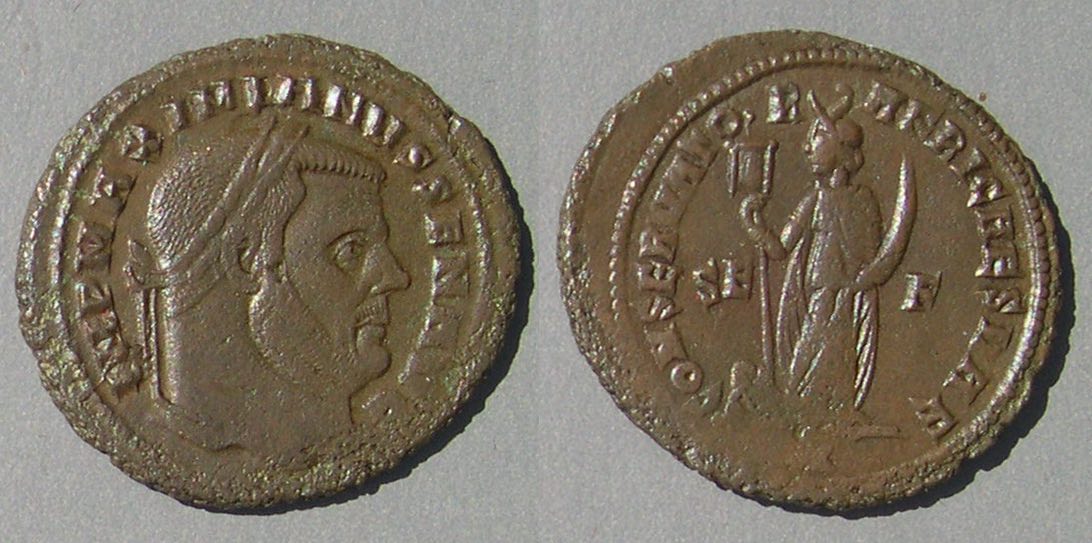 Maximian under Maxentius.
Maximian under Maxentius.
29-27 mm. 9.09 grams.
IMP MAXIMIANVS SEN AVG
CONSERVATOR AFRICA SVAE, Africa standing holding standard and elephant tusk, lion at feet.
SE F across fields
A in exergue
RIC VI Carthage 56, struck "c. late November 306-early 307"
That is, shortly after Maxentius took power, Oct. 28, 306.
24 mm. 7.48 grams.
IMP MAXIMIANVS SEN AVG
CONSERVATORES KART SVAE, 6-column temple, Carthago standing within holding up fruits.
PKA in exergue.
RIC VI Carthage 59, "summer 307"
Type S3: CONSERV VRBS SVAE, 6-column temple. Maximian.

25 mm. 7.35 grams.
IMP C MAXIMIANVS P F AVG
Maximian, with a legend sometimes used by Galerius. The nose makes it clear this coin is of Maximian and not Galerius, and so does the fact the type was initiated by Maxentius.
CONSERV VRBS SVAE, 6-column temple, Roma within.
RIC VI Aquileia 121b, struck "Autumn 307- c. 309/10"
This type is shared with Maxentius, Maxentius as AVG CONS II, and Constantine as Augustus.
[Same type, but from Ticinum.]
26-25 mm. 6.04 grams.
IMP C MAXIMIANVS P F AVG
CONSERV VRBS SVAE, 6-column temple, Roma within.
RIC VI Ticinum 92, struck "c. autumn 307-spring 308."
This type is shared with Maxentius and Constantine. as Augustus.
Type S4: GENIO POPVLI ROMANI, genius standing. Maximian.
27-26 mm. 7.98 grams.
DN MAXIMIANVS P F S AVG
GENIO POPVLI ROMANI
altar at feet left, N in field right
PLC in exergue.
RIC VI Lugdunum 206, "c. spring 307."
By late summer the type had changed to the shortened legend
GENIO POP ROM [next].
In this issue Diocletian also had the title "S AVG" but not this type; his type in this issue was QVIES AVGVSTORVM (illustrated above).
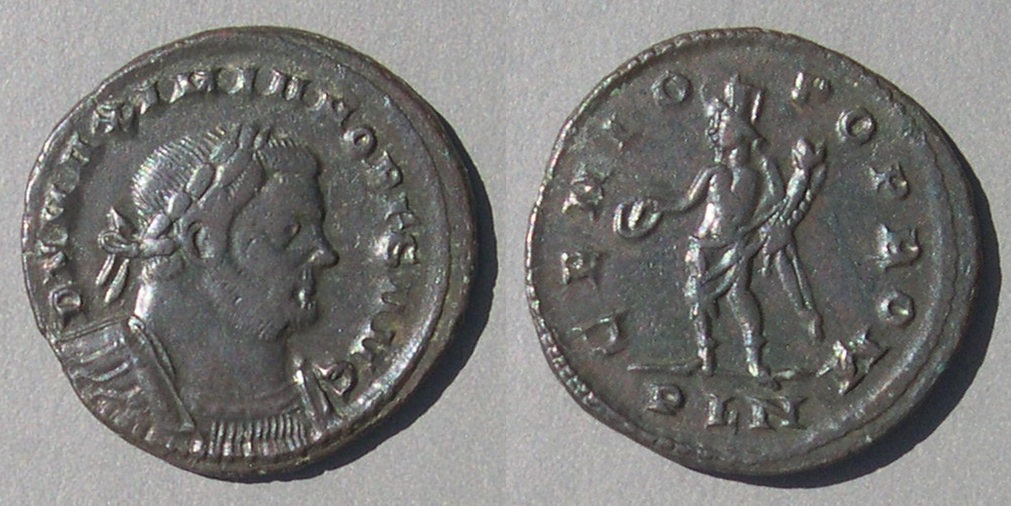
This reverse type is also very rare for the retired Diocletian with obverse legend DN DIOCLETIANO AETER AVG, only at Lugdunum c. autumn 307 - summer 308. That issue includes Maximian as (second-reign) Augustus, Galerius as "MAXIMIANVS IVN AVG," Constantine as Augustus, Maxentius as Augustus, and Maximinus II as Caesar [p.260f].
Constantine and Maximian recognize each other as active Augusti. In 307, in an attempt to retake Rome, the Augustus Severus II was defeated and soon executed by Maxentius. Constantine took the title Augustus as expected of a Caesar under the tetrarchal system. Galerius prepared a second attempt to retake Rome. Maximian, under Maxentius, went to Constantine to solicit his help. He confirmed Constantine had the title Augustus (or, maybe, awarded it to him at this time), and cemented an alliance by giving his daughter Fausta (sister of Maxentius) to Constantine in marriage. The mints of Constantine have Constantine, Maximian, and Maxentius all as Augusti, all with title IMP. Coins with "DN" were no longer issued. The GENIO POP ROM type continued to be issued, but with restored "active" titles. DN is replaced by IMP and Senior omitted.
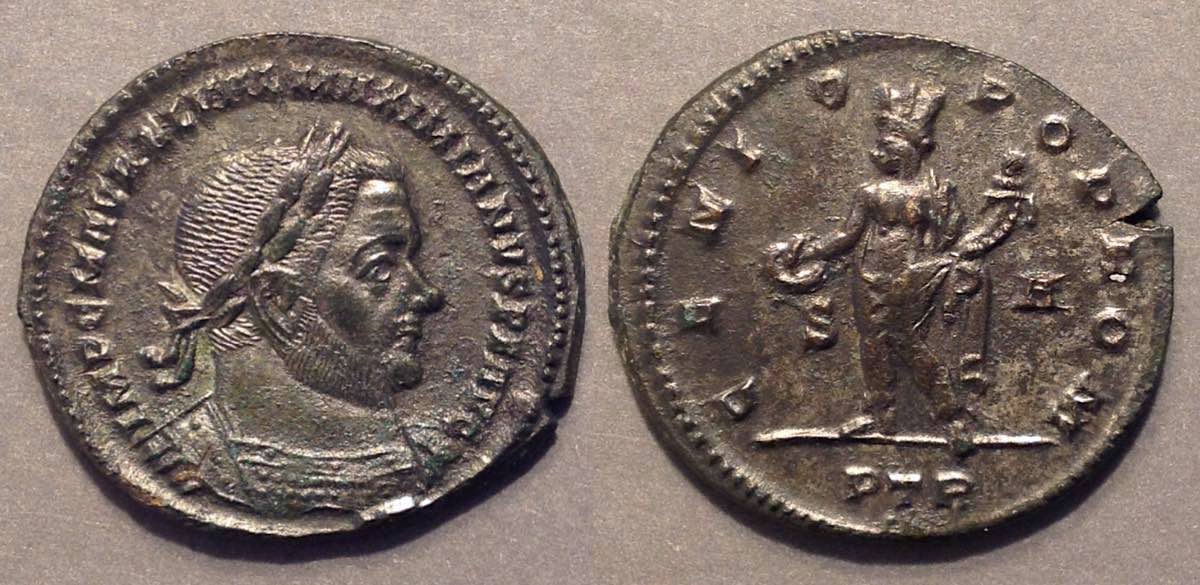 Maximian, recognized as Augustus at a mint of Constantine.
Maximian, recognized as Augustus at a mint of Constantine.
27-25 mm. 7.18 grams,
IMP C M AVREL VAL MAXIMIANVS P F AVG
Note the remarkably long version of his name which makes it clear this is not a coin of Galerius.
GENIO POP ROM
Altar in left field
PLG in exergue
RIC Trier 766 "autumn 307 - end of 308."
Type S7: AE fractions with vows for thirty years. These are rare.
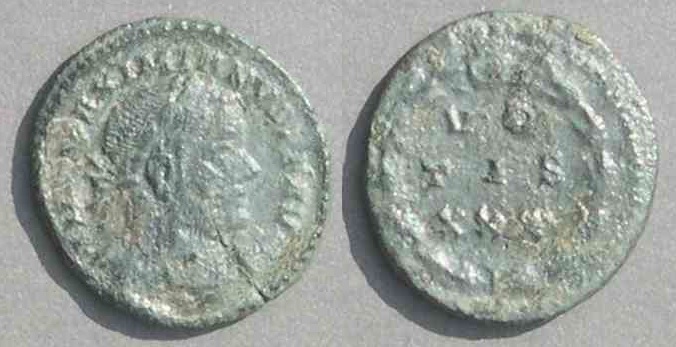
Maximian.
18-17 mm. 1.98 grams. "1/4 follis"
IMP MAXIMIANVS P F AVG
Struck summer 307 for his second reign, taking vows for 30 years.
VO/TIS/XXX
RIC VI Trier 754 page 214 "R, c. summer 307"
Zschucke 7.14, page 48. "1/4, by Constantine, for July 25, 307."
 Maximian.
Maximian.Third reign. The so-called "third reign" of Maximian refers to the period after the Conference at Carnuntum in November 308 until his death in Spring 310. Very few third-reign coins were issued for Maximian and those only at Antioch--far from the western part of the empire where he had reigned.
First reign: With Diocletian, 286-May 305, until forced to retire when Diocletian retired.
Retired: May 305 and later.
Second reign: late 306 to late 308, when invited to resume his title of Augustus by Maxentius until deposed by the Conference at Carnuntum.
Third reign: late 308 until 310, after the Conference at Carnuntum until his death in 310. This period is distinguished by the presence on coins of Licinius who was elevated to Augustus at the Conference.
Type S8: GENIO IMPERATORIS, third reign. Only at Antioch.
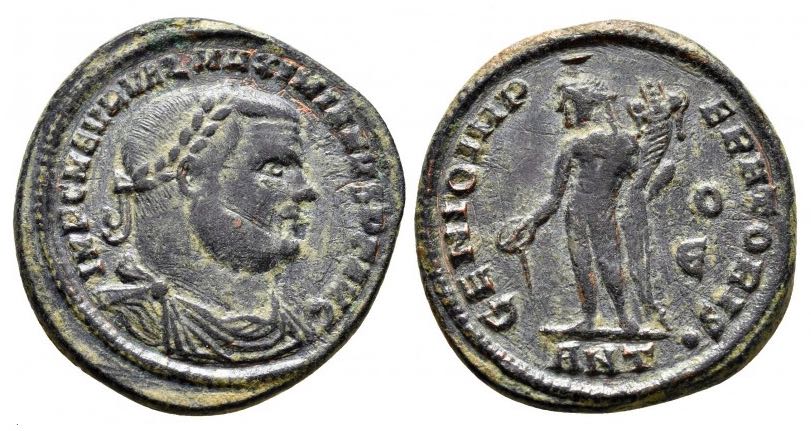 Maximian, third reign.
Maximian, third reign.
25-24 mm. 7.22 grams
IMP C M AVR VAL MAXIMIANVS P F AVG
GENIO IMPERATORIS
O
Є [Є is the only officina for Maximian]
ANT •
RIC VI Antioch 112c "early to later 309"
This issue (with this combination of mint- and field-marks) is shared with Galerius (common from all 10 officina, A-I, see the second next coin) and Licinius ("scarce" from only officina A, see the next coin). The co-ruler Licinius proves this coin is from the period of Maximian's third reign.
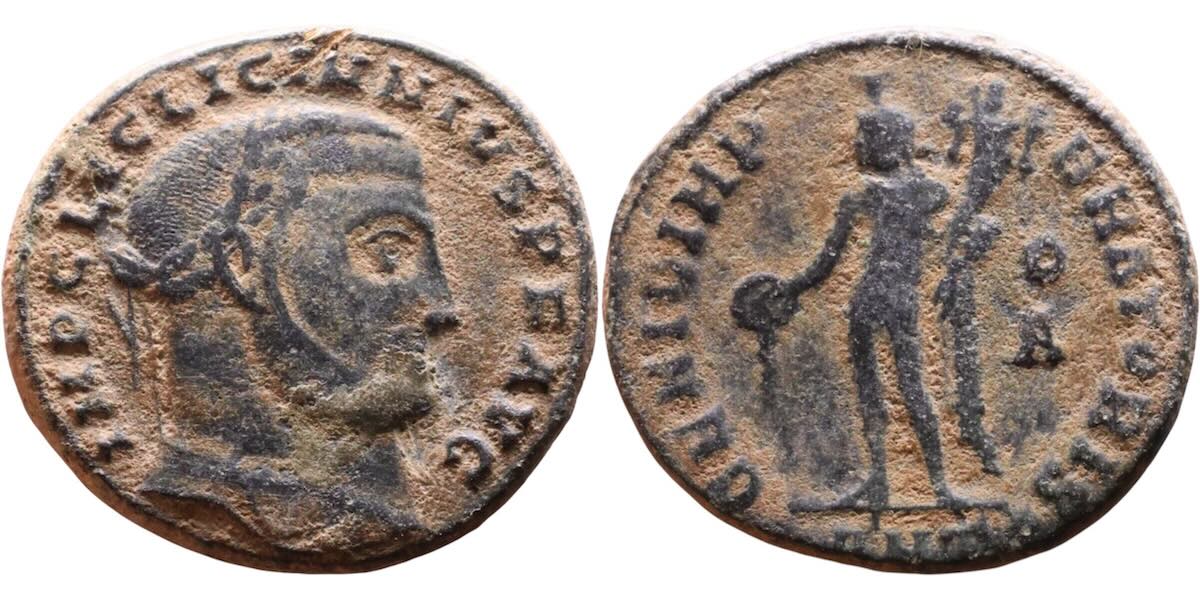
Licinius, first issue at Antioch, c. "early to later 309"
24-23 mm. 6.90 grams.
IMP C LIC LICINNIVS PF AVG
(The early spelling with "NN")
This one has officina A where Maximinus has "Є".
RIC VI Antioch 112b, page 632.
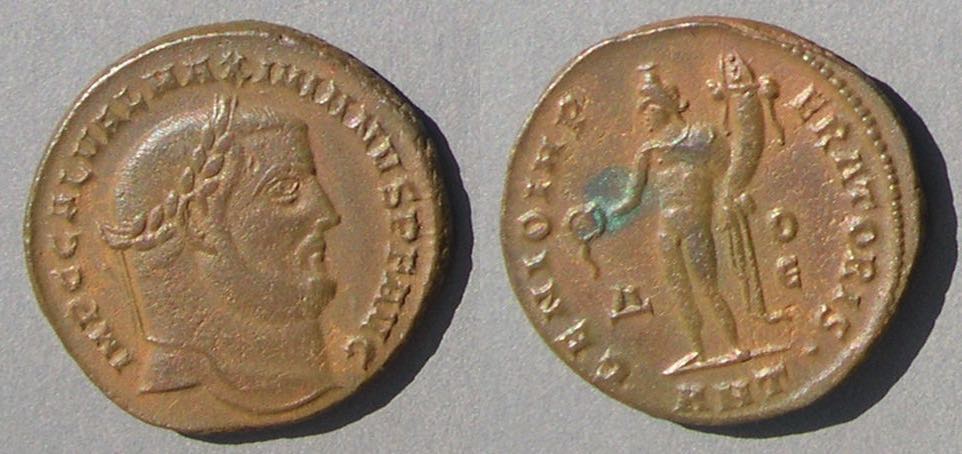 Galerius, Augustus 305-311
Galerius, Augustus 305-311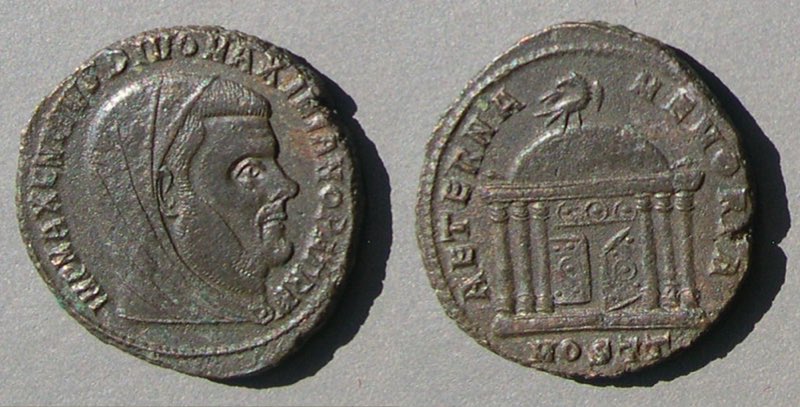
Divus Maximianus, d. 310. Struck by Maxentius, c. 310.
23 mm.
IMP MAXENTIVS DIVO MAXIMIANO PATRI (3:30-5:00)
PATRI = father
AETERNA MEMORIA
Domed temple with six coumns, doors ajar, eagle on top.
MOSTT in exergue.
Maximianus was the father of Maxentius. He had been Augustus for twenty years when forced into retirement upon Diocletian's retirement in 305. After a short retirement and two aborted comebacks, he was forced to commit suicide by Constantine in 310. Maxentius had obvious reason to claim his relationship to his father who had been Augustus for over twenty years.
RIC VI Ostia 26
Constantine issued three types of commemoratives for each of three deceased members of his family: Claudius II (The evidence that Claudius II was related to Constantine is not strong, so it may be they were not related, but Constantine thought adopting him into the family would be good propaganda), Constantius (his father) and Maximian (his father in law). All have obverse legends beginning DIVO followed by the emperor's name. The three reverses are:
1) MEMORIAE AETERNAE with a standing eagle with wings half spread
2) MEMORIAE AETERNAE with a lion standing right (sometimes with a club above), and
3) REQVIES OPTIMORVM MERITORVM (sometimes abbreviated) with the emperor seated left on a curule chair.
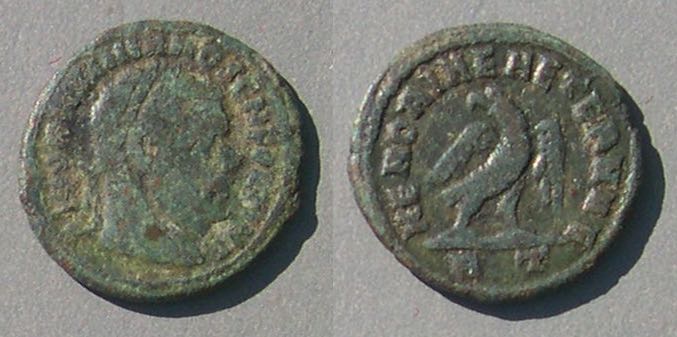 DIVO MAXIMIANO SEN FORT IMP
DIVO MAXIMIANO SEN FORT IMP
MEMORIAE AETERNAE with a standing eagle with wings half spread.
17-16 mm.
R T in exergue
RIC VII Rome 110 "317-318"
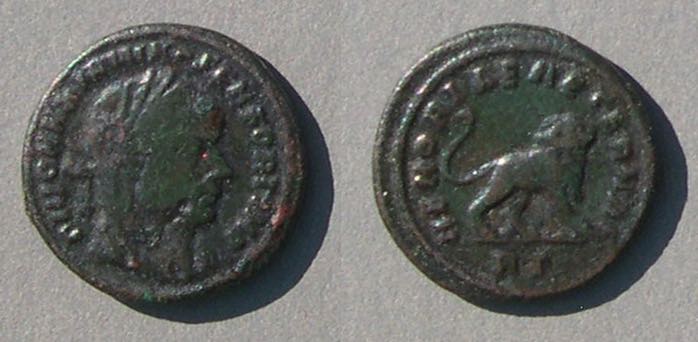 DIVO MAXIMIANO SEN FORT IMP
DIVO MAXIMIANO SEN FORT IMP DIVO MAXIMIANO SEN FORT IMP
DIVO MAXIMIANO SEN FORT IMP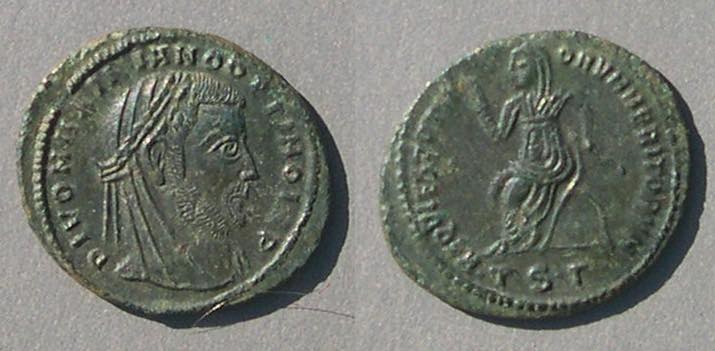 DIVO MAXIMIANO OPTIMO IMP
DIVO MAXIMIANO OPTIMO IMPAttributions of second-reign issues from Carthage.
 Are there second-reign coins of this type? I chose not to list it. RIC Carthage 50 has this obverse legend and reverse type SALVIS AVGG ET CAESS FEL KART with an "H" in the left field which is dated to the second reign of Maximian, whereas this example is RIC 27b, is dated to c. 298-9 and not second-reign.
Are there second-reign coins of this type? I chose not to list it. RIC Carthage 50 has this obverse legend and reverse type SALVIS AVGG ET CAESS FEL KART with an "H" in the left field which is dated to the second reign of Maximian, whereas this example is RIC 27b, is dated to c. 298-9 and not second-reign.
This common type from Carthage was issued long before his second reign and there is some question about whether it continued into his second reign. RIC Carthage 50 for Maximian is given to the second reign, but is not easily distinguishable from his first-reign issues (for which there are numerous mint and control marks) or from extremely similar coins of Galerius with the same obverse legend in the previous issue (RIC Carthage 39b for Galerius).
I think it is likely that RIC Carthage 50 is really of Galerius. It may be that examples (which I have not seen) of that issue have the distinctive nose of Maximian, but that does not make them second-reign coins. I have chosen to not list this type as second-reign; I don't think the minor mintmark variety of RIC 50 is enough to prove any part of the common coins of Maximian of this type were second reign coins.
Not Maximian. Telling coins of Maximian and Galerius apart can be difficult because, at different times, both sometimes used the same legend "IMP MAXIMIANVS P F AVG." The time period of the next coin is identifed by the co-rulers in the issue. GENIO POP ROM is a legend from after the first retirement of Maximian.
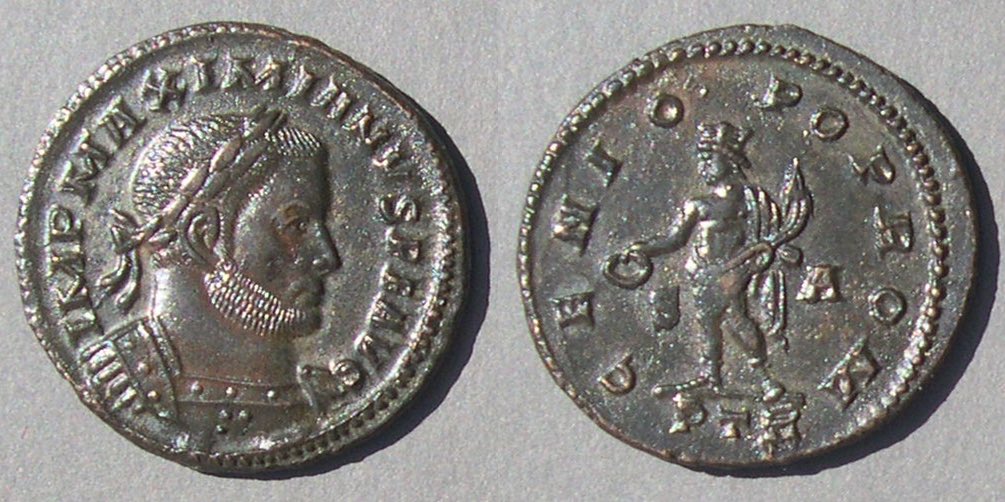 26 mm. 6.63 grams.
26 mm. 6.63 grams.
IMP MAXIMIANVS P F AVG
In spite of this legend, it is a coin of Galerius, not Maximian.
GENIO POP ROM
S A across field
PTR in exergue
RIC VI Trier 714. "c. summer 307". This group is shared by Galerius with Constantine as Caesar, Maximinus II as Caesar, and, according to RIC, half-folles of Maximian with this exact same legend! The portrait looks like Galerius rather than Maximian and it is from Trier, apparently before Maximian began his second reign. RIC and I both attribute it to Galerius, not to the second reign of Maximian.
Conclusion: Diocletian and Maximian had retirement types that explicitly refer to retirement. After Maxentius usurped power in 306, Maximian began his "second reign" and had second-reign types shared with Maxentius (but, of course, Diocletian does not). Maximian has very few coins from his "third reign" after the Conference at Carnuntum. He had commemoratives issued in his name by Maxentius, his son, and by Constantine, his son in law.
References:
